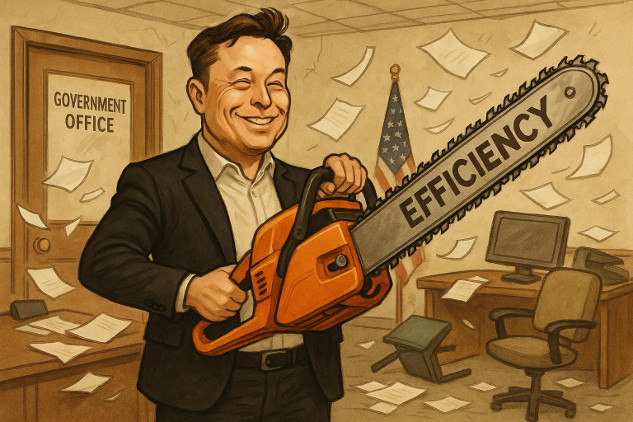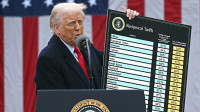
When ‘Efficiency’ Means Cutting the Wrong Things: A satirical look at the Trump/Musk DOGE disaster.
In This Article
- What led to the mass layoffs under the DOGE initiative?
- How did the rehiring process unfold, and at what cost?
- Why did privatization efforts fail to deliver promised efficiencies?
- Who holds accountability for the missteps in government restructuring?
- What lessons can be learned for future government efficiency endeavors?
The Incredible Incompetence to Make the Government More Efficient
by Robert Jennings, InnerSelf.com
For decades now, Americans have been told that their government is bloated, wasteful, and incapable of delivering results. Republicans, in particular, have turned “government inefficiency” into a political hobby horse, rolling it out every election cycle as if it were a newly discovered truth. But when you actually look at the numbers, this narrative collapses under its own weight.
The core U.S. federal workforce—excluding the Postal Service and program-funded entities like Social Security and Medicare—makes up only about 0.6 percent of the U.S. population. That is one of the lowest ratios among advanced nations. Total public sector employment across all levels of the U.S. government accounts for approximately 13 percent of the workforce, significantly lower than the 25 to 30 percent seen in Nordic countries and lower than in the U.K. and Australia.
And what do Americans get for their money? Less than citizens of those countries because the U.S. tax burden is also one of the lowest among the G7. Americans pay about 26.6 percent of GDP in taxes, while Germans pay 38 percent, and the Nordic nations pay well over 40 percent. Despite this, the U.S. government shoulders a global role—providing international security, aid, and leadership—that no other nation matches. Inefficient? Hardly.
Privatization: Where Real Waste Lives
If you want to find inefficiency in the U.S. system, you need not look to the federal workforce. You need to examine what happens when ideological crusades lead to the privatization of functions that should remain public. Take healthcare: the U.S. spends more than $4.5 trillion annually, with at least $2 trillion of that representing sheer waste. Administrative overhead, fragmented billing systems, and profit-driven middlemen—all combine to make American healthcare the most expensive and less effective than many in the developed world.
And it is not just healthcare. Privatization has infected prisons, military logistics, student loans, and even essential infrastructure projects. Each time, the pitch is the same: the private sector will be more efficient. But the reality is far from it. Each time, the result is a bloated mess of contractors, inflated costs, and diminished public accountability. Farming out public responsibility to companies whose sole goal is profit is a dangerous way to build an efficient society.
The DOGE Debacle
Perhaps no recent episode better illustrates the folly of this mindset than the Trump administration’s Department of Government Efficiency (DOGE) initiative. In 2025, Trump empowered Elon Musk to lead DOGE with a simple mission: cut the federal workforce and save money. This initiative was part of a broader effort to reduce the size of government, a goal that many of Trump's supporters had long championed. Russell Vought, one of Trump’s ideological enforcers, cheered the move, as did many others who long dreamed of dismantling the “deep state.”
The result? Chaos. Agencies such as the FDA, IRS, and USAID saw their critical staff slashed overnight. The Department of Energy’s National Nuclear Security Administration lost technical experts who could not be replaced fast enough. Even the IRS, the agency responsible for collecting revenue, was gutted—leading to an estimated $500 billion in lost tax receipts. Meanwhile, services Americans rely on ground to a halt, and legal challenges piled up.
Now, in an embarrassing about-face, many of the same federal employees are being rehired at significant cost. The Partnership for Public Service estimates that the DOGE fiasco will cost over $135 billion in 2025 alone, not counting the longer-term losses due to inefficiency.
The Buck Stops Here
It would be convenient to blame all of this on Elon Musk and his brash management style. But that would be a cop-out. The ultimate responsibility lies with Donald Trump, who authorized the DOGE purge, and with figures like Russell Vought, who designed and defended it. This was not a rogue operation—it was the product of deliberate policy choices made at the highest level of government.
As President Harry S. Truman famously said, “The buck stops here.” Truman understood that leadership means taking responsibility for outcomes, not passing the blame when things go wrong. The Trump administration’s failure to own the consequences of the DOGE initiative stands in stark contrast to that ethic. If anything, Trump and his allies have doubled down on their rhetoric, even as the evidence of their failure mounts.
The Real Cost of the Anti-Government Crusade
The DOGE episode should be a wake-up call. The problem is not that the U.S. government is too large or inefficient. It is that ideological efforts to dismantle government have made it less capable of doing its job. Every time public institutions are hollowed out and functions are handed to private actors with little accountability, inefficiency grows. Public trust erodes. And when disaster strikes—as it inevitably does—it turns out that you need those public servants after all.
The Republican narrative about “government bloat” is not just false. It is actively dangerous. It undermines the very capacity of government to serve the public good. Americans should reject this narrative and engage in an honest conversation about what kind of government we want—and what we need to make it work well. That starts with facts, not ideology. The point is this: our government is lean, and it can be improved, but it is not the cause of the inefficiency that plagues American society. The real culprits are those who, in the name of efficiency, have left us with a more expensive, less functional system.
Michael Lewis: In Defense of Competent Government
For those still tempted to believe the rhetoric about government bloat, a timely corrective comes from bestselling author Michael Lewis. His latest book, Who Is Government?, offers a vivid portrait of the federal workforce—one that challenges the stereotypes peddled by politicians and cable news. Lewis profiles the career public servants who, despite political attacks and budget cuts, continue to deliver vital services under often impossible conditions. Their dedication and resilience are a testament to the value of public service.
As Lewis points out, the inefficiencies Americans encounter are not due to the number of federal workers but rather to political interference, underfunding, and decades of efforts to undermine public institutions. The very agencies targeted by Trump’s DOGE initiative—like the FDA and IRS—are, in Lewis’s telling, staffed by professionals whose mission is to serve the public good. Gutting these agencies does not make the government more efficient; it makes it less capable of protecting Americans’ health, safety, and financial well-being.
Lewis’s book serves as a timely reminder that the problem isn’t that we have too much government. The problem is that too many of our leaders lack interest in making government work effectively. They would rather sabotage it than point to the resulting dysfunction as proof of their own cynical narrative. In that sense, the fundamental inefficiency is not bureaucratic—it is political.
For anyone tired of the endless political noise about “bloated government” and wondering what actually goes on inside the federal workforce, Michael Lewis’s new book, Who Is Government?, is a must-read. In classic Lewis style—sharp, engaging, and deeply human—he takes us inside the world of career public servants who keep the machinery of government running, even as they’re demonized by the very leaders who depend on them. From food safety to disaster response to national security, Lewis shows how these unsung professionals quietly deliver the services Americans rely on every day. His book is a powerful counterweight to decades of ideological attacks—and a reminder that competent government isn’t the problem; it’s the solution.
Who Is Government?: The Untold Story of Public Service
 For anyone tired of the endless political noise about “bloated government” and wondering what actually goes on inside the federal workforce, Michael Lewis’s new book, Who Is Government?, is a must-read. In classic Lewis style—sharp, engaging, and deeply human—he takes us inside the world of career public servants who keep the machinery of government running, even as they’re demonized by the very leaders who depend on them.
For anyone tired of the endless political noise about “bloated government” and wondering what actually goes on inside the federal workforce, Michael Lewis’s new book, Who Is Government?, is a must-read. In classic Lewis style—sharp, engaging, and deeply human—he takes us inside the world of career public servants who keep the machinery of government running, even as they’re demonized by the very leaders who depend on them.
From food safety to disaster response to national security, Lewis shows how these unsung professionals quietly deliver the services Americans rely on every day. His book is a powerful counterweight to decades of ideological attacks—and a reminder that competent government isn’t the problem; it’s the solution. Order your copy here.
Notes
1. Estimates of U.S. healthcare waste vary but consistently point to at least $1.5 to $2 trillion annually in administrative overhead, pricing failures, and fragmented care delivery—inefficiencies largely absent in single-payer systems. Sources: Commonwealth Fund, NPR, and various peer-reviewed studies.
2. International comparisons of public sector employment can be misleading without context. In the U.S., many public services (healthcare, education, policing) are delivered at the state and local level, making the federal workforce proportionally much smaller compared to centralized systems in Nordic and European nations.
3. The $135 billion+ estimated cost of the DOGE-driven federal rehiring effort reflects not only direct rehiring expenses but also productivity losses, legal settlements, and increased contract spending to compensate for short-term staffing gaps. Source: Partnership for Public Service analysis, reported by the Washington Post.
References
• Pew Research Center: Federal Workforce Data, 2025
• OECD Public Sector Employment Chart
• Washington Post: Federal Workforce Rehiring After DOGE Layoffs
About the Author
 Robert Jennings is the co-publisher of InnerSelf.com, a platform dedicated to empowering individuals and fostering a more connected, equitable world. A veteran of the U.S. Marine Corps and the U.S. Army, Robert draws on his diverse life experiences, from working in real estate and construction to building InnerSelf with his wife, Marie T. Russell, to bring a practical, grounded perspective to life’s challenges. Founded in 1996, InnerSelf.com shares insights to help people make informed, meaningful choices for themselves and the planet. More than 30 years later, InnerSelf continues to inspire clarity and empowerment.
Robert Jennings is the co-publisher of InnerSelf.com, a platform dedicated to empowering individuals and fostering a more connected, equitable world. A veteran of the U.S. Marine Corps and the U.S. Army, Robert draws on his diverse life experiences, from working in real estate and construction to building InnerSelf with his wife, Marie T. Russell, to bring a practical, grounded perspective to life’s challenges. Founded in 1996, InnerSelf.com shares insights to help people make informed, meaningful choices for themselves and the planet. More than 30 years later, InnerSelf continues to inspire clarity and empowerment.
Creative Commons 4.0
This article is licensed under a Creative Commons Attribution-Share Alike 4.0 License. Attribute the author Robert Jennings, InnerSelf.com. Link back to the article This article originally appeared on InnerSelf.com
Recommended books:
Capital in the Twenty-First Century
by Thomas Piketty. (Translated by Arthur Goldhammer)
 In Capital in the Twenty-First Century, Thomas Piketty analyzes a unique collection of data from twenty countries, ranging as far back as the eighteenth century, to uncover key economic and social patterns. But economic trends are not acts of God. Political action has curbed dangerous inequalities in the past, says Thomas Piketty, and may do so again. A work of extraordinary ambition, originality, and rigor, Capital in the Twenty-First Century reorients our understanding of economic history and confronts us with sobering lessons for today. His findings will transform debate and set the agenda for the next generation of thought about wealth and inequality.
In Capital in the Twenty-First Century, Thomas Piketty analyzes a unique collection of data from twenty countries, ranging as far back as the eighteenth century, to uncover key economic and social patterns. But economic trends are not acts of God. Political action has curbed dangerous inequalities in the past, says Thomas Piketty, and may do so again. A work of extraordinary ambition, originality, and rigor, Capital in the Twenty-First Century reorients our understanding of economic history and confronts us with sobering lessons for today. His findings will transform debate and set the agenda for the next generation of thought about wealth and inequality.
Click here for more info and/or to order this book on Amazon.
Nature's Fortune: How Business and Society Thrive by Investing in Nature
by Mark R. Tercek and Jonathan S. Adams.
 What is nature worth? The answer to this question—which traditionally has been framed in environmental terms—is revolutionizing the way we do business. In Nature’s Fortune, Mark Tercek, CEO of The Nature Conservancy and former investment banker, and science writer Jonathan Adams argue that nature is not only the foundation of human well-being, but also the smartest commercial investment any business or government can make. The forests, floodplains, and oyster reefs often seen simply as raw materials or as obstacles to be cleared in the name of progress are, in fact as important to our future prosperity as technology or law or business innovation. Nature’s Fortune offers an essential guide to the world’s economic—and environmental—well-being.
What is nature worth? The answer to this question—which traditionally has been framed in environmental terms—is revolutionizing the way we do business. In Nature’s Fortune, Mark Tercek, CEO of The Nature Conservancy and former investment banker, and science writer Jonathan Adams argue that nature is not only the foundation of human well-being, but also the smartest commercial investment any business or government can make. The forests, floodplains, and oyster reefs often seen simply as raw materials or as obstacles to be cleared in the name of progress are, in fact as important to our future prosperity as technology or law or business innovation. Nature’s Fortune offers an essential guide to the world’s economic—and environmental—well-being.
Click here for more info and/or to order this book on Amazon.
Beyond Outrage: What has gone wrong with our economy and our democracy, and how to fix it -- by Robert B. Reich
 In this timely book, Robert B. Reich argues that nothing good happens in Washington unless citizens are energized and organized to make sure Washington acts in the public good. The first step is to see the big picture. Beyond Outrage connects the dots, showing why the increasing share of income and wealth going to the top has hobbled jobs and growth for everyone else, undermining our democracy; caused Americans to become increasingly cynical about public life; and turned many Americans against one another. He also explains why the proposals of the “regressive right” are dead wrong and provides a clear roadmap of what must be done instead. Here’s a plan for action for everyone who cares about the future of America.
In this timely book, Robert B. Reich argues that nothing good happens in Washington unless citizens are energized and organized to make sure Washington acts in the public good. The first step is to see the big picture. Beyond Outrage connects the dots, showing why the increasing share of income and wealth going to the top has hobbled jobs and growth for everyone else, undermining our democracy; caused Americans to become increasingly cynical about public life; and turned many Americans against one another. He also explains why the proposals of the “regressive right” are dead wrong and provides a clear roadmap of what must be done instead. Here’s a plan for action for everyone who cares about the future of America.
Click here for more info or to order this book on Amazon.
This Changes Everything: Occupy Wall Street and the 99% Movement
by Sarah van Gelder and staff of YES! Magazine.
 This Changes Everything shows how the Occupy movement is shifting the way people view themselves and the world, the kind of society they believe is possible, and their own involvement in creating a society that works for the 99% rather than just the 1%. Attempts to pigeonhole this decentralized, fast-evolving movement have led to confusion and misperception. In this volume, the editors of YES! Magazine bring together voices from inside and outside the protests to convey the issues, possibilities, and personalities associated with the Occupy Wall Street movement. This book features contributions from Naomi Klein, David Korten, Rebecca Solnit, Ralph Nader, and others, as well as Occupy activists who were there from the beginning.
This Changes Everything shows how the Occupy movement is shifting the way people view themselves and the world, the kind of society they believe is possible, and their own involvement in creating a society that works for the 99% rather than just the 1%. Attempts to pigeonhole this decentralized, fast-evolving movement have led to confusion and misperception. In this volume, the editors of YES! Magazine bring together voices from inside and outside the protests to convey the issues, possibilities, and personalities associated with the Occupy Wall Street movement. This book features contributions from Naomi Klein, David Korten, Rebecca Solnit, Ralph Nader, and others, as well as Occupy activists who were there from the beginning.
Click here for more info and/or to order this book on Amazon.
Article Recap
The Trump administration’s misguided push for "government efficiency" through the DOGE initiative resulted in mass layoffs and a costly rehiring process. The U.S. federal workforce remains one of the leanest among developed nations, while privatization and political sabotage—not government size—drive real inefficiencies. As this debacle shows, competent public institutions matter. Americans must reject the false narrative of government bloat and hold leaders accountable for the inefficiency they create.
#GovernmentEfficiency #FederalWorkforce #DOGEInitiative #TrumpAdministration #PrivatizationFails








